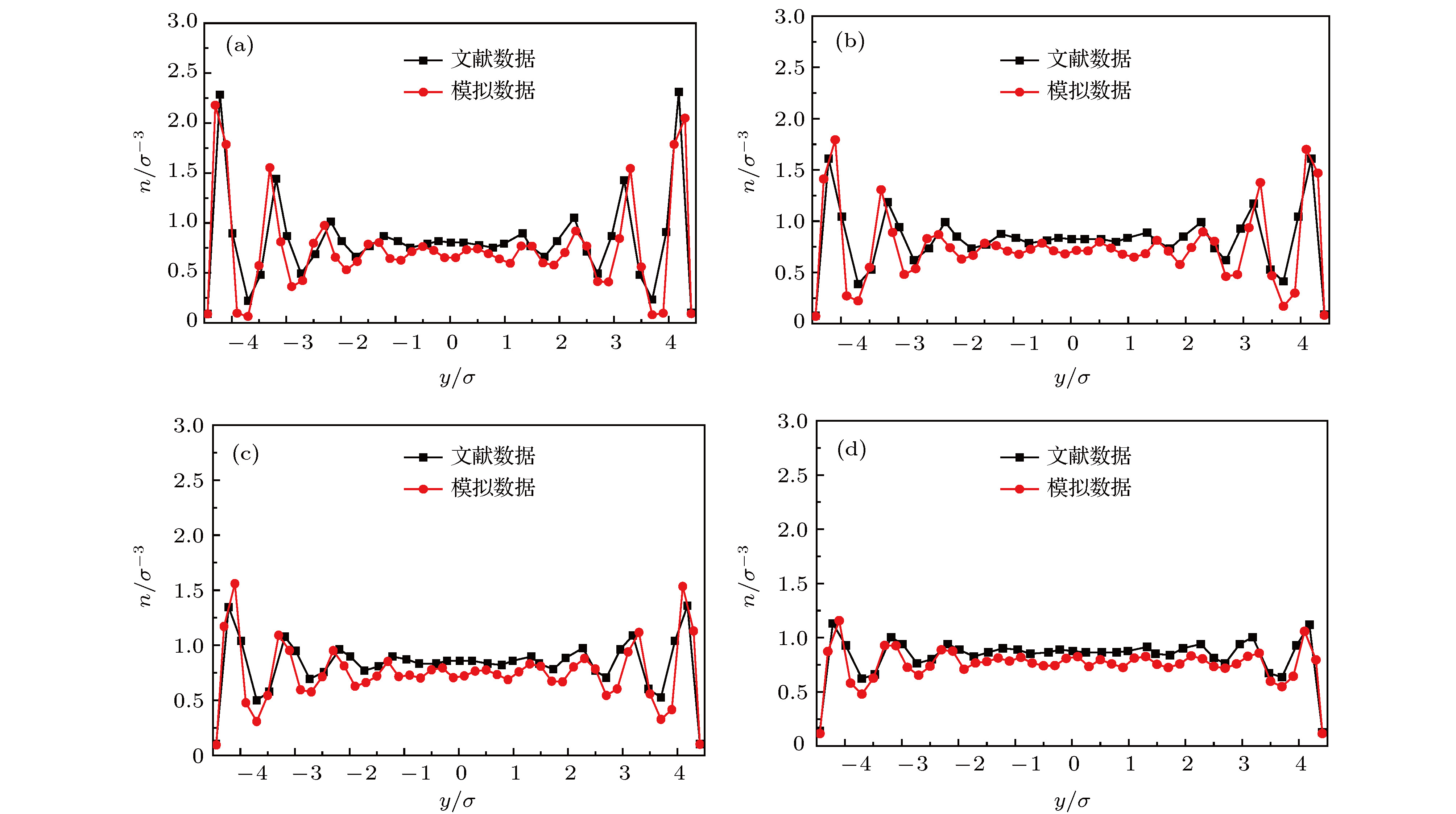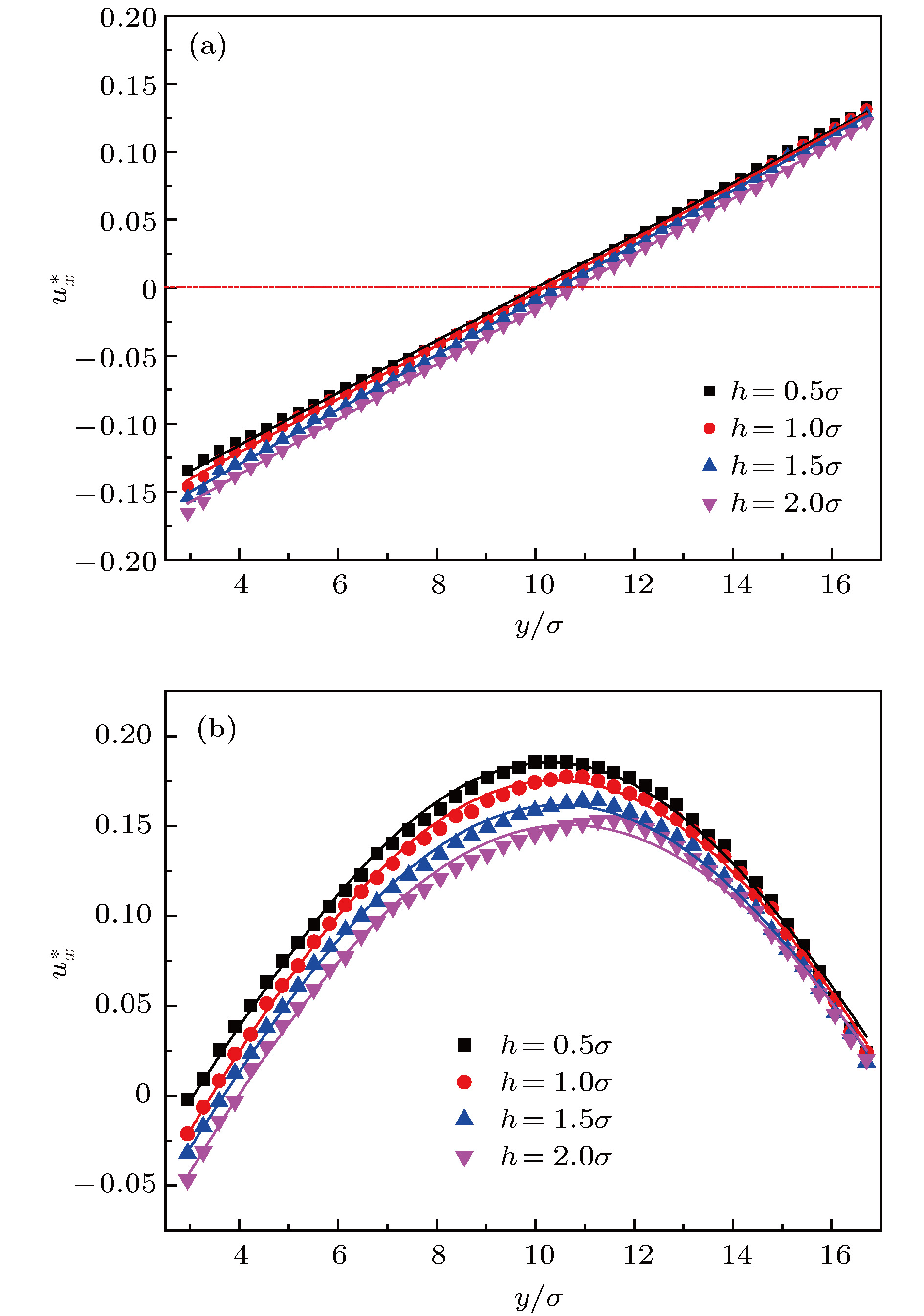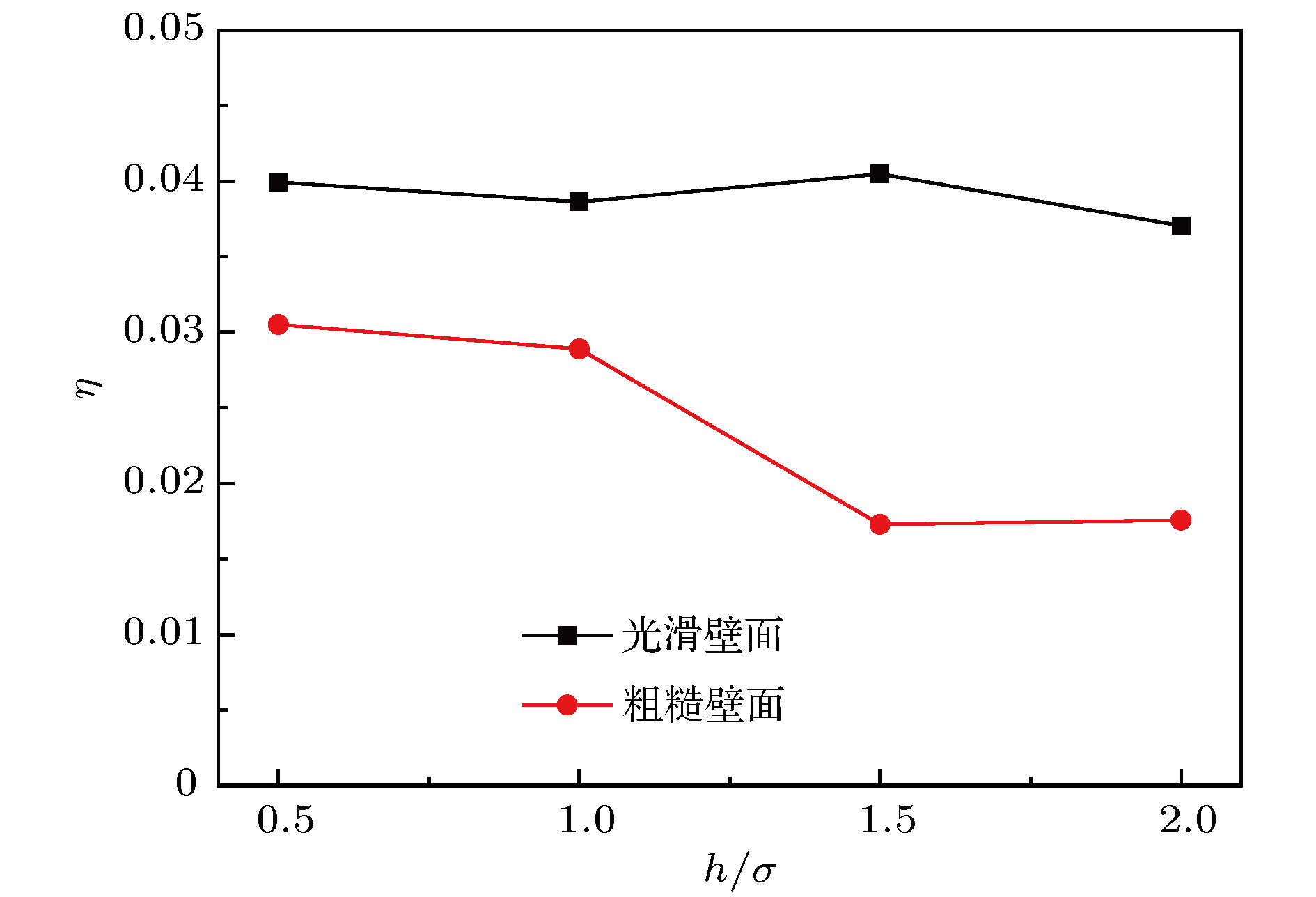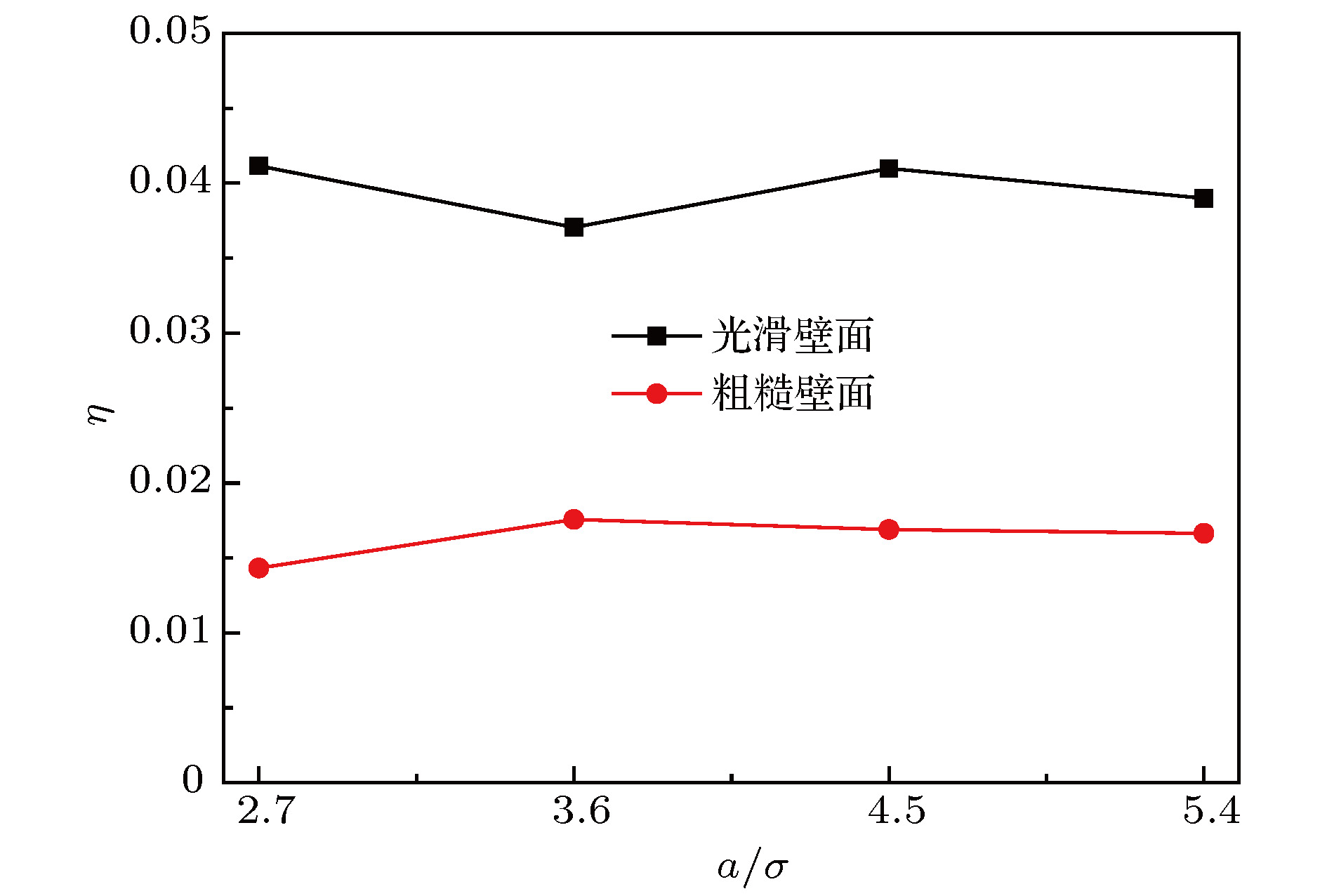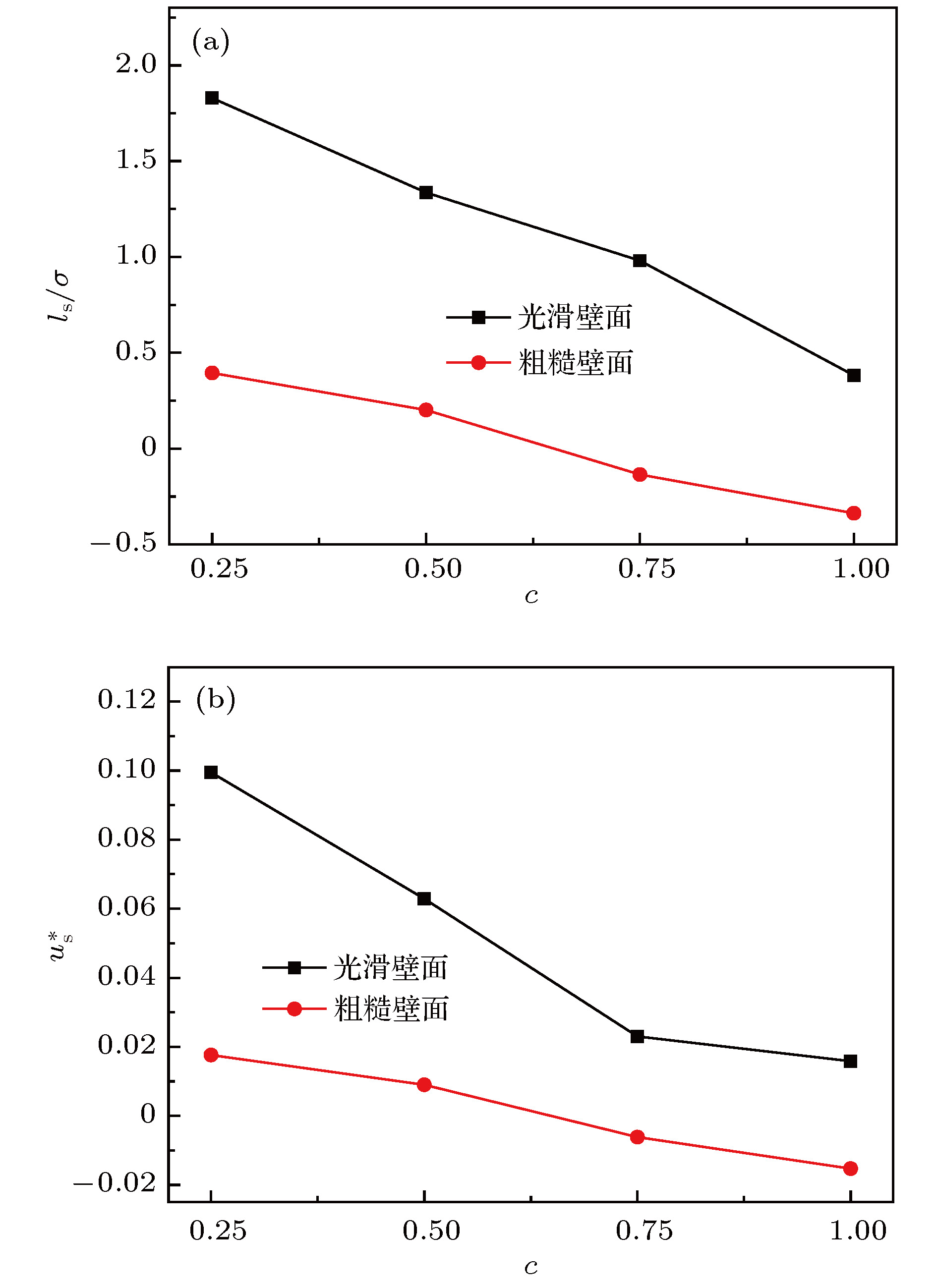-
Flow system on a nano scale, as an effective and economic system, has been widely employed. While on a macroscopic scale, for the non-slip boundary, the velocity of the fluid at the surface is assumed to be consistent with the surface. This approximation may become invalid on a smaller length scale pertinent to the operation of microfluid devices. The interface slip effect has a significant influence on the flow because of its higher ratio of surface to volume. In this paper, the Poiseuille flow, which is composed of two infinite parallel asymmetric walls, is studied by the molecular dynamics method. The influence of wall roughness and surface wettability of channel on fluid flow in the channel are analyzed. The results show that the asymmetric upper and lower wall can lead to an asymmetric distribution of flow parameters. The change of wall roughness and wettability would affect the flow characteristics of fluid atoms near the wall. Due to the influence of wall grooves, the number density distribution near the rough wall is lower than that on the smooth wall side. As the rib height and wall wettability increase, the number density of fluid atoms in the groove increases gradually, and the change of the rib spacing does not substantially affect the number density distribution of fluid atoms near the rough wall. For different structure types of walls, the real solid-liquid boundary positions are determined by simulating the velocity field distribution in the channel under both Couette flow and Poiseuille flow, which can help us to better analyze the interface slip effect. The variation of wall roughness and wettability can affect the position of the solid-liquid interface. The change of rib height and wettability can greatly influence the velocity distribution in channel, and the position of the solid-liquid boundary as well. Conversely, the rib spacing has a less effect on the boundary position. The difference in boundary position can affect the interface slip effect. We can find the slip velocity and the slip length on one side of the rough wall to be smaller than those on the smooth wall side, and as the rib height and wall wettability increase, the slip velocity and the slip length significantly decrease near the rough wall side. The effect of rib spacing on fluid flow is trivial, and the interface slip velocity and length are relatively stable.
-
Keywords:
- roughness /
- wettability /
- interface slip /
- molecular dynamics
[1] 黄桥高, 潘光, 宋保维 2014 物理学报 63 054701
 Google Scholar
Google Scholar
Huang Q G, Pan G, Song B W 2014 Acta Phys. Sin. 63 054701
 Google Scholar
Google Scholar
[2] 葛宋, 陈民 2013 工程热物理学报 34 1527
Ge S, Cheng M 2013 J. Eng. Therm. 34 1527
[3] 顾骁坤, 陈民 2010 工程热物理学报 31 1724
Gu X K, Cheng M 2010 J. Eng. Therm. 31 1724
[4] Sun M, Ebner C 1992 Phys. Rev. Lett. 69 3491
 Google Scholar
Google Scholar
[5] Voronov R S, Papavassiliou D V, Lee L L 2007 Chem. Phys. Lett. 441 273
 Google Scholar
Google Scholar
[6] 胡海豹, 鲍路瑶, 黄苏和 2013 力学学报 45 507
 Google Scholar
Google Scholar
Hu H B, Bao L Y, Huang S H 2013 Chin. J. Theor. Appl. Mech. 45 507
 Google Scholar
Google Scholar
[7] Nagayama G, Cheng P 2004 Int. J. Heat Mass Transfer 47 501
 Google Scholar
Google Scholar
[8] Barisik M, Beskok A 2011 Microfluid. Nanofluid. 11 269
 Google Scholar
Google Scholar
[9] Shi Z, Barisik M, Beskok A 2012 Int. J. Therm. Sci. 59 29
 Google Scholar
Google Scholar
[10] 张冉, 谢文佳, 常青 2018 物理学报 67 084701
 Google Scholar
Google Scholar
Zhang R, Xie W J, Chang Q 2018 Acta Phys. Sin. 67 084701
 Google Scholar
Google Scholar
[11] Cieplak M 2001 Phys. Rev. Lett. 86 803
 Google Scholar
Google Scholar
[12] 闫寒, 张文明, 胡开明, 刘岩, 孟光 2013 物理学报 62 174701
 Google Scholar
Google Scholar
Yan H, Zhang W M, Hu K M, Liu Y, Meng G 2013 Acta Phys. Sin. 62 174701
 Google Scholar
Google Scholar
[13] 张程宾, 许兆林, 陈永平 2014 物理学报 63 214706
 Google Scholar
Google Scholar
Zhang C B, Xu Z L, Chen Y P 2014 Acta Phys. Sin. 63 214706
 Google Scholar
Google Scholar
[14] Rahmatipour H, Azimian A R, Atlaschian O 2017 Phys. A 465 159
 Google Scholar
Google Scholar
[15] Toghraie D, Mokhtari M, Afrand M 2016 Physica E 84 152
 Google Scholar
Google Scholar
[16] Zhang Z Q, Yuan L S, Liu Z, Cheng G G, Ye H F, Ding J N 2018 Comput. Mater. Sci. 145 184
 Google Scholar
Google Scholar
[17] Cao B Y, Sun J, Chen M, Guo Z Y 2009 Int. J. Mol. Sci. 10 4638
 Google Scholar
Google Scholar
[18] Cao B Y, Chen M, Guo Z Y 2006 Phys. Rev. E 74 066311
 Google Scholar
Google Scholar
[19] Cao B Y, Chen M, Guo Z Y 2006 Int. J. Eng. Sci. 44 927
 Google Scholar
Google Scholar
[20] Xie J F, Cao B Y 2017 Mol. Simul. 43 65
[21] Tretyakov N, Müller M 2013 Soft Mater. 9 3613
 Google Scholar
Google Scholar
[22] Plimpton S 1995 J. Comput. Phys. 117 1
 Google Scholar
Google Scholar
[23] 曹炳阳, 陈民, 过增元 2006 物理学报 55 5305
 Google Scholar
Google Scholar
Cao B Y, Chen M, Guo Z Y 2006 Acta Phys. Sin. 55 5305
 Google Scholar
Google Scholar
[24] Schmatko T, Hervet H, Léger L 2006 Langmuir 22 6843
 Google Scholar
Google Scholar
[25] Thompson P A, Robbins M O 1990 Phys. Rev. A 41 6830
 Google Scholar
Google Scholar
-
表 1 不同模拟工况下对应的粗糙度与接触角
Table 1. Corresponding roughness and contact angle under different simulation conditions.
模拟工况 r θ/(°) (c = 1.0) θ/(°) (c = 0.75) θ/(°) (c = 0.5) θ/(°) (c = 0.25) h = 0 0 0 60 90 120 h = 0.45σ, a = 3.6σ 1.143 0 55.21 90 124.79 h = 0.9σ, a = 3.6σ 1.286 0 50 90 130 h = 1.35σ, a = 3.6σ 1.429 0 44.44 90 135.56 h = 1.8σ, a = 3.6σ 1.571 0 38.22 90 141.78 h = 1.8σ, a = 2.7σ 1.667 0 33.64 90 146.36 h = 1.8σ, a = 4.5σ 1.500 0 41.38 90 138.62 h = 1.8σ, a = 5.4σ 1.444 0 43.80 90 136.20 -
[1] 黄桥高, 潘光, 宋保维 2014 物理学报 63 054701
 Google Scholar
Google Scholar
Huang Q G, Pan G, Song B W 2014 Acta Phys. Sin. 63 054701
 Google Scholar
Google Scholar
[2] 葛宋, 陈民 2013 工程热物理学报 34 1527
Ge S, Cheng M 2013 J. Eng. Therm. 34 1527
[3] 顾骁坤, 陈民 2010 工程热物理学报 31 1724
Gu X K, Cheng M 2010 J. Eng. Therm. 31 1724
[4] Sun M, Ebner C 1992 Phys. Rev. Lett. 69 3491
 Google Scholar
Google Scholar
[5] Voronov R S, Papavassiliou D V, Lee L L 2007 Chem. Phys. Lett. 441 273
 Google Scholar
Google Scholar
[6] 胡海豹, 鲍路瑶, 黄苏和 2013 力学学报 45 507
 Google Scholar
Google Scholar
Hu H B, Bao L Y, Huang S H 2013 Chin. J. Theor. Appl. Mech. 45 507
 Google Scholar
Google Scholar
[7] Nagayama G, Cheng P 2004 Int. J. Heat Mass Transfer 47 501
 Google Scholar
Google Scholar
[8] Barisik M, Beskok A 2011 Microfluid. Nanofluid. 11 269
 Google Scholar
Google Scholar
[9] Shi Z, Barisik M, Beskok A 2012 Int. J. Therm. Sci. 59 29
 Google Scholar
Google Scholar
[10] 张冉, 谢文佳, 常青 2018 物理学报 67 084701
 Google Scholar
Google Scholar
Zhang R, Xie W J, Chang Q 2018 Acta Phys. Sin. 67 084701
 Google Scholar
Google Scholar
[11] Cieplak M 2001 Phys. Rev. Lett. 86 803
 Google Scholar
Google Scholar
[12] 闫寒, 张文明, 胡开明, 刘岩, 孟光 2013 物理学报 62 174701
 Google Scholar
Google Scholar
Yan H, Zhang W M, Hu K M, Liu Y, Meng G 2013 Acta Phys. Sin. 62 174701
 Google Scholar
Google Scholar
[13] 张程宾, 许兆林, 陈永平 2014 物理学报 63 214706
 Google Scholar
Google Scholar
Zhang C B, Xu Z L, Chen Y P 2014 Acta Phys. Sin. 63 214706
 Google Scholar
Google Scholar
[14] Rahmatipour H, Azimian A R, Atlaschian O 2017 Phys. A 465 159
 Google Scholar
Google Scholar
[15] Toghraie D, Mokhtari M, Afrand M 2016 Physica E 84 152
 Google Scholar
Google Scholar
[16] Zhang Z Q, Yuan L S, Liu Z, Cheng G G, Ye H F, Ding J N 2018 Comput. Mater. Sci. 145 184
 Google Scholar
Google Scholar
[17] Cao B Y, Sun J, Chen M, Guo Z Y 2009 Int. J. Mol. Sci. 10 4638
 Google Scholar
Google Scholar
[18] Cao B Y, Chen M, Guo Z Y 2006 Phys. Rev. E 74 066311
 Google Scholar
Google Scholar
[19] Cao B Y, Chen M, Guo Z Y 2006 Int. J. Eng. Sci. 44 927
 Google Scholar
Google Scholar
[20] Xie J F, Cao B Y 2017 Mol. Simul. 43 65
[21] Tretyakov N, Müller M 2013 Soft Mater. 9 3613
 Google Scholar
Google Scholar
[22] Plimpton S 1995 J. Comput. Phys. 117 1
 Google Scholar
Google Scholar
[23] 曹炳阳, 陈民, 过增元 2006 物理学报 55 5305
 Google Scholar
Google Scholar
Cao B Y, Chen M, Guo Z Y 2006 Acta Phys. Sin. 55 5305
 Google Scholar
Google Scholar
[24] Schmatko T, Hervet H, Léger L 2006 Langmuir 22 6843
 Google Scholar
Google Scholar
[25] Thompson P A, Robbins M O 1990 Phys. Rev. A 41 6830
 Google Scholar
Google Scholar
Catalog
Metrics
- Abstract views: 16009
- PDF Downloads: 149
- Cited By: 0















 DownLoad:
DownLoad:

